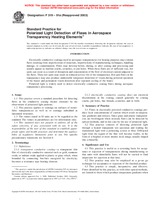We need your consent to use the individual data so that you can see information about your interests, among other things. Click "OK" to give your consent.
ASTM F319-91a(2003)
Standard Practice for Polarized Light Detection of Flaws in Aerospace Transparency Heating Elements (Includes all amendments And changes 12/31/2010).
Automatically translated name:
Standard Practice for Polarized Light Detection of Flaws in Aerospace Transparency Heating Elements
STANDARD published on 1.10.2003
The information about the standard:
Designation standards: ASTM F319-91a(2003)
Note: WITHDRAWN
Publication date standards: 1.10.2003
SKU: NS-54972
The number of pages: 3
Approximate weight : 9 g (0.02 lbs)
Country: American technical standard
Category: Technical standards ASTM
Annotation of standard text ASTM F319-91a(2003) :
Keywords:
coatings, conductive coatings, heating elements, polarized light, polarized light inspection, ICS Number Code 49.060 (Aerospace electric equipment and systems)
Additional information
| Significance and Use |
|
This practice is useful as a screening basis for acceptance or rejection of transparencies during manufacturing so that units with identifiable flaws will not be carried to final inspection for rejection at that time. This practice may also be employed as a go-no go technique for acceptance or rejection of the finished product. This practice is simple, inexpensive, and effective. Flaws identified by this practice, as with other optical methods, are limited to those which produce temperature gradients when electrically powered. Any other type of flaw, such as minor scratches parallel to the direction of electrical flow, are not detectable. If another method (equally suitable for flaw detection) is designated for final optical inspection of the laminated part under power, the polarized light practice will not be required for the final inspection. |
| 1. Scope |
|
1.1 This practice covers a standard procedure for detecting flaws in the conductive coating (heater element) by the observation of polarized light patterns. 1.2 This practice applies to coatings on surfaces of monolithic transparencies as well as to coatings imbedded in laminated structures. 1.3 The values stated in SI units are to be regarded as the standard. The values in parentheses are for information only. 1.4 This standard does not purport to address all of the safety concerns, if any, associated with its use. It is the responsibility of the user of this standard to establish appropriate safety and health practices and determine the applicability of regulatory limitations prior to use. For specific precautionary statements see Section 6. |
We recommend:
Technical standards updating
Do you want to make sure you use only the valid technical standards?
We can offer you a solution which will provide you a monthly overview concerning the updating of standards which you use.
Would you like to know more? Look at this page.




 Cookies
Cookies
